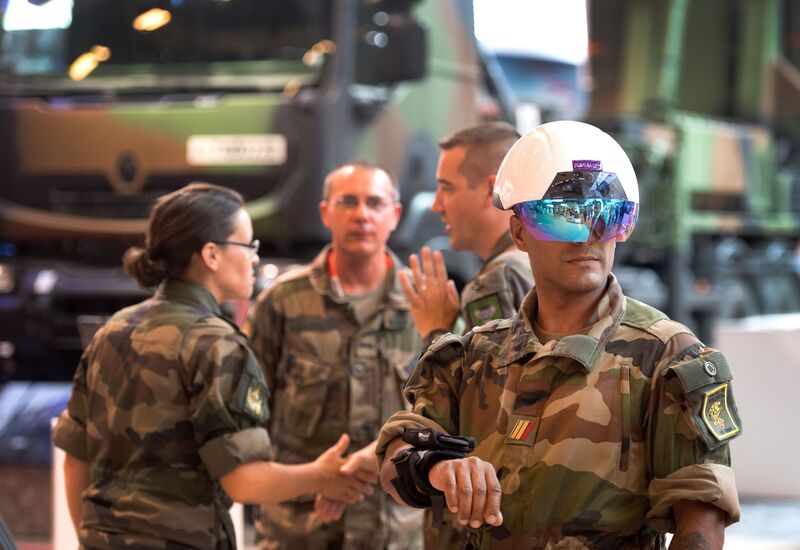Consumer applications for augmented reality, like gaming and the metaverse aren’t making money, but military contracts are highly lucrative.
By Tim Culpan / March 26, 2023
For more than a decade, technology pioneers have toiled away making virtual reality headsets in the hope that one day there’ll be a compelling and profitable need for these devices. There isn’t. That’s unless you’re the US military and believe soldiers in the field will be more effective, and safer, when equipped with head-worn gadgetry.
Oculus, founded by an 18-year-old called Palmer Luckey, was an earlier VR leader, followed shortly after by smartphone maker HTC Corp. They envisioned selling headsets to consumers who would sit at home playing more immersive games, or simply watching whales swim by. Sony Corp. and Samsung Electronics Co. were also eager to be part of what they hoped would be a boom to rival the smartphone era.
But these devices were expensive, heavy and not very good. The environments may have been virtual, but the headaches and nausea were real. Less than 10 million headsets were sold last year, according to researcher IDC Corp., versus 1.2 billion handsets.
Still, some executives remain convinced that everyone will soon be living in the metaverse, where the internet and the physical world blend through interconnected 3D scenes. Mark Zuckerberg’s then-Facebook Inc. ponied up $2 billion in 2014 to buy Oculus, later changing the name of the device and the company to Meta to reflect a future beyond social media.
Last week, Meta Platforms Inc. laid off a further 10,000 people, after cutting 11,000 positions in November as an advertising slowdown collides with the metaverse’s failure to launch. The company’s Reality Labs division, which comprises everything from headsets to avatars, has lost more than $20 billion to date and predicts it will continue to burn money this year.
Microsoft Corp. is also trying to break into this business, but instead of chasing consumers, it’s trying to land corporate customers who would use its HoloLens system in professional settings such as medical education and engineering. This focus mimics the software giant’s own turnaround a decade ago from selling operating systems for computers to cloud computing and data storage for enterprises.
And when it comes to major customers, there’s none larger than the US government. In 2018, the Redmond-based company beat out unicorn startup Magic Leap Inc. to land a $479 million deal to develop a prototype headset based on the HoloLens augmented reality device.
VR Isn’t Getting Much Traction
Expensive, heavy and nauseating. Virtual and augmented reality headsets haven’t been found compelling despite years of effort.

While VR cuts a person off from the real world, making them entirely reliant on computer-generated sights and sounds, AR systems interact with the surroundings. The eyes and ears can sense what’s going on, while also being augmented with a simulated environment. For the military, locking a soldier’s eyes behind a screen is too risky; if there’s a power failure or technical glitch, they could be left blind.
The US Army believes that enhancing, rather than replacing, a soldier’s senses could give them the advantage. Other nations agree, with Israel among those deploying the technology. China has its own version, while the U.K. is preparing to use VR for training.
The invention of night-vision goggles, and improvement in that technology, allowed the American military to “own the night” and conduct high-risk operations by leveraging their visual advantage in, for example, the 2011 raid in Pakistan that killed al-Qaeda leader Osama bin Laden. But that edge is being weakened by the proliferation of night-vision goggles among armed opposition groups and terrorist organizations around the world.
Augmented reality could offer military units the kind of upper hand night-vision did in the past. In addition to improved optics in low light, AR systems are expected to allow troops to recognize and track friendly forces, pick out enemies, map the surrounding terrain and even interact with unmanned vehicles. A soldier could watch through the eyes of a drone to get a bird’s eye view, or see around corners. It would offer the situational awareness of a first-person shooter game to a person who’s in active combat.
It’s been a rough ride, though. Having impressed the army with its prototype, Microsoft won a subsequent contract two years ago to bring the device into production with a contract worth up to $21.88 billion. Further testing in the field found many of the same problems couch-surfers experienced, including nausea and eyestrain.
Instead of approving the next round of procurement money, which would have bought thousands more devices, Congress froze almost $400 million in funds for the Integrated Visual Augmentation System to be spent this year until the problems could be worked out. As a result, the army gave out a new contract in January, worth just $125 million, to develop an improved variant of IVAS.
While much has been made of these hiccups, and the reduced budget, the overall trajectory of the project remains unchanged. With technology an increasingly important differentiator on the battlefield, there’s little chance that the government will nix plans to give soldiers an edge.
It also gives companies like Microsoft and defense supplier Northrop Grumman Corp. a competitive advantage, because not only is the military a tough client to please, it’s one with deep pockets and a willingness to spend money on moonshot projects. And if they can solve the problems withAR headsets, it’s likely those advances will flow through to consumer devices, so that Zuckerberg can hang out in the metaverse with all his friends.
To contact the author of this story:
Tim Culpan at tculpan1@bloomberg.net
To contact the editor responsible for this story:
Ruth Pollard at rpollard2@bloomberg.net
Source: https://www.bloomberg.com/opinion/articles/2023-03-26/military-technology-microsoft-has-a-22-billion-case-for-ar?leadSource=uverify%20wall

